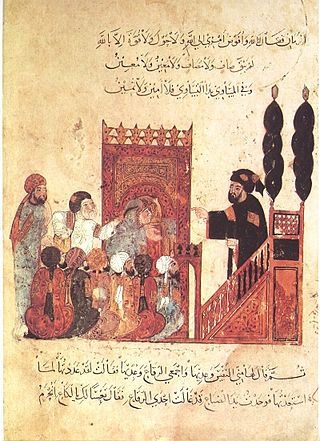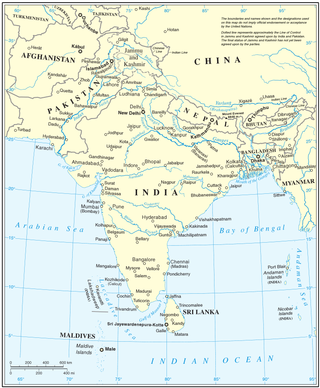Sheikh Ubaidullah | |
|---|---|
| Personal | |
| Born | 41 AH/663 AD Medina, Hejaz |
| Died | Andrott, Lakshadweep, India |
| Religion | Sunni Islam |
| Era | Islamic golden age |
| Part of a series on |
| Islam |
|---|
 |
Shiekh Ubaidullah (born c. 663 AD) was a Muslim Arab from Medina.
Sheikh Ubaidullah | |
|---|---|
| Personal | |
| Born | 41 AH/663 AD Medina, Hejaz |
| Died | Andrott, Lakshadweep, India |
| Religion | Sunni Islam |
| Era | Islamic golden age |
| Part of a series on |
| Islam |
|---|
 |
Shiekh Ubaidullah (born c. 663 AD) was a Muslim Arab from Medina.
The name Ubaidullah is an indirect Quranic name that means "little servant of God". Ubaid is the diminutive form of the word Abd ("servant") and is formed from Ubaid ("little servant") and Allah ("God"), -u- being the case marking for the nominative (in construct state). [1]
Nothing is known about his early life except his lineage which is traced to Caliph Abu Bakr, the first Rashidun Caliph, to whom he is believed to be closely related. [2]
Tradition says that once while praying in the Prophet's mosque in Medina Ubaidullah fell asleep and saw a dream in which he saw Muhammad who told him to go to distant lands east of Jeddah to preach Islam to the people. [3]
He interpreted the dream as a divine vision from God for his salvation and the people of those distant lands, so he proceeded to Jeddah where he travelled across the ocean for accomplishing his mission. [4]
On his journey his vessel capsized in a storm and he had to continue his journey by drifting on a plank till he reached Amini in AH 41 (663 AD). He started his act of preaching from Amini and was able to convert the Pondambelli family despite the initial linguistic challenges. After facing opposition there he left Amini with some of his new Muslim fellows and moved to Andrott where he got significantly high conversions. He then went to Kavaratti and Agatti, preaching there and then came back to Amini. This time unlike his first arrival in Amini, he was welcomed and via his preaching could successfully influence and convert almost the whole of population to Islam. At last stage of his life, he travelled to Andrott where he lived the rest of his life preaching and teaching. Ubaidullah never went back to his home land of Hijaz and devoted his life for dawah. [3] Sheikh Ubaidullah advanced Islam in Lakshadweep (now in India) Islands by delivering sermons before the islanders.
Apparently, he died at Andrott Island with his remains buried in Juma Mosque. [5] [6]
Juma Mosque, one of the top attractions in Lakshadweep is said to have been built during his time.
It is believed that 97% of the population in Lakshadweep being Muslim at present is a result of his preaching. [7]

Abd Allah ibn Abi Quhafa, known by his kunyaAbu Bakr, was the first Rashidun caliph ruling from 632 until his death in 634. As a senior companion of Muhammad and, through his daughter Aisha, also his father-in-law, Abu Bakr is referred to with the honorific title al-Siddiq by Sunni Muslims.

Umar ibn al-Khattab, also spelled Omar, was the second Rashidun caliph, ruling from August 634, when he succeeded Abu Bakr as the second caliph, until his assassination in 644. Umar was a senior companion and father-in-law of the Islamic prophet Muhammad.

Khutbah serves as the primary formal occasion for public preaching in the Islamic tradition.

Mu'awiya I was the founder and first caliph of the Umayyad Caliphate, ruling from 661 until his death. He became caliph less than thirty years after the death of the Islamic prophet Muhammad and immediately after the four Rashidun ('rightly-guided') caliphs. Unlike his predecessors, who had been close, early companions of Muhammad, Mu'awiya was a relatively late follower of Muhammad.

Custodian of the Two Holy Mosques, or Protector of the Two Holy Cities, is a royal style that has been used officially by the monarchs of Saudi Arabia since 1986. The title has historically been used by many Muslim rulers in the past, including the Ayyubids, the Mamluks, the Ottomans and the Sharifain rulers of Hejaz. The title was sometimes regarded to denote the de facto Caliph of Islam, but it mainly refers to the ruler taking the responsibility of guarding and maintaining the two holiest mosques in Islam: Al-Haram Mosque in Mecca and the Prophet's Mosque in Medina, both of which are in the Hejazi region of Saudi Arabia. The Custodian has been named the most powerful and influential person in Islam and the Sunni branch of Islam by The Muslim 500, as well as the most powerful Muslim and Arab ruler in the world.

The Rashidun are the first four caliphs who led the Muslim community following the death of Muhammad: Abu Bakr, Umar, Uthman, and Ali.

William Henry Quilliam, who changed his name to Abdullah Quilliam and later Henri Marcel Leon or Haroun Mustapha Leon, was a 19th-century British convert from Christianity to Islam, noted for founding England's first mosque and Islamic centre.

Lakshadweep is a union territory of India. It is an archipelago of 36 islands divided into three island subgroups: the Laccadive Islands in the middle with the Amindivi Islands in the north separated roughly by the 11th parallel north and the atoll of Minicoy to the south separated by the Nine Degree Channel along the 9th parallel north. The islands are sandwiched between the Arabian Sea to the west and the Laccadive Sea to the east with the islands located about 220–440 km (140–270 mi) off the Malabar Coast of mainland India.
Andrott Island, also known as Androth Island, is a small inhabited island in the Union Territory of Lakshadweep, a group of 36 coral islands scattered in the Arabian Sea off the western coast of India. It has a distance of 293 km (182 mi) west of the city of Kochi.
Islamic religious leaders have traditionally been people who, as part of the clerisy, mosque, or government, performed a prominent role within their community or nation. However, in the modern contexts of Muslim minorities in non-Muslim countries as well as secularised Muslim states like Turkey, and Bangladesh, the religious leadership may take a variety of non-formal shapes.

Ubaidullah Sindhi was a political activist of the Indian independence movement and one of its vigorous leaders. According to Dawn, Karachi, Maulana Ubaidullah Sindhi struggled for the independence of British India and for an exploitation-free society in India. He was also Home Minister of first Provisional Government of India established in Afghanistan in 1915.

Mirza Basheer-ud-Din Mahmood Ahmad was the second caliph, leader of the worldwide Ahmadiyya Muslim Community and the eldest son of Mirza Ghulam Ahmad from his second wife, Nusrat Jahan Begum. He was elected as the second successor of Mirza Ghulam Ahmad on 14 March 1914 at the age of 25, the day after the death of his predecessor Hakim Nur-ud-Din.

Jamia Ashrafia, Lahore, Pakistan, is a religious educational institution founded by Mufti Muhammad Hassan in 1947. The university has produced numerous scholars of Islam, serving various sectors of life.

Khwaja Kamal-ud-Din was a prominent figure of the early Ahmadiyya movement and the author of numerous works about Islam.

The Silk Letter Movement refers to a movement organised by Deobandi leaders between 1913 and 1920, aimed at gaining Indian independence from British rule by forming an alliance with the Ottoman Empire, the Emirate of Afghanistan and the German Empire. This plot was uncovered by the Punjab CID with the capture of letters from Ubaidullah Sindhi, one of the Deobandi leaders then in Afghanistan, to Mahmud Hasan Deobandi, another leader then in Hejaz. The letters were written on silk cloth, hence the name.

Both Sunni Muslims and Shia Muslims agree on the three Holiest sites in Islam being, respectively, the Masjid al-Haram, in Mecca; the Al-Masjid an-Nabawi, in Medina; and Al-Masjid al-Aqsa, in Jerusalem.

The Sharifian Caliphate was a caliphate proclaimed by the Sharifian leaders of the Hejaz in 1924, replacing the Ottoman Caliphate, which was abolished by Mustafa Kemal Atatürk. Even though the Banu Hashim held the caliphate at various points in history, Hussein bin Ali, the Sharif of Mecca, was the first and last caliph of this lineage.

The Vilayet of the Hejaz refers to the Hejaz region of Arabia when it was administered as a first-level province (vilayet) of the Ottoman Empire. At the beginning of the 20th century, it reportedly had an area of 96,500 square miles (250,000 km2). The Hejaz included all land from the southern border of the Vilayet of Syria, south of the city of Ma‛an, to the northern border of the Vilayet of Yemen, north of the city of Al Lith.

Arakkal Kingdom was a Muslim kingdom in Kannur town in Kannur district, in the state of Kerala, South India. The king was called Ali Raja and the ruling queen was called Arakkal Beevi. Arakkal kingdom included little more than the Cannanore town and the southern Laccadive Islands, originally leased from the Kolattiri. The royal family is said to be originally a branch of the Kolattiri, descended from a princess of that family who converted to Islam. They owed allegiance to the Kolattiri rulers, whose ministers they had been at one time. The rulers followed the Marumakkathayam system of matrilineal inheritance, a system that is unique to a section of Hindus of Kerala. Under Marumakkathayam, the succession passes to the male offspring of its female members, in other words from a man to his sister's son and so forth. As the only Muslim rulers in Malabar, they saw the rise of Hyder Ali, de facto ruler of the Mysore Sultanate as the opportunity to increase their own power at the expense of Chirakkal, and invited him to invade Kerala.

Islam is the second-largest religion in South Asia, with more than 640 million Muslims living there, forming about one-third of the region's population. Islam first spread along the coastal regions of the Indian subcontinent and Sri Lanka, almost as soon as it started in the Arabian Peninsula, as the Arab traders brought it to South Asia. South Asia has the largest population of Muslims in the world, with about one-third of all Muslims living here. Islam is the dominant religion in half of the South Asian countries. It is the second largest religion in India and third largest in Sri Lanka and Nepal.